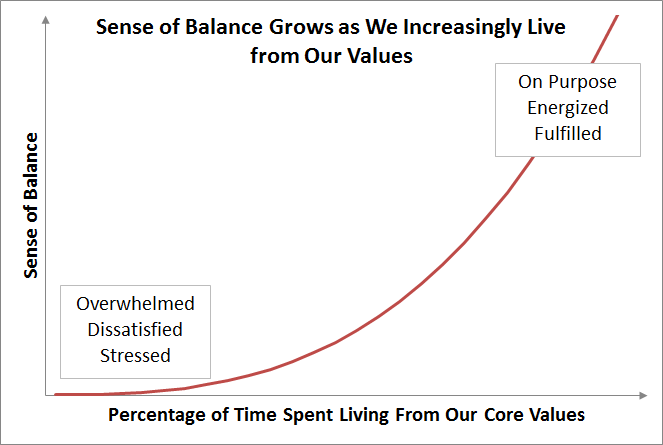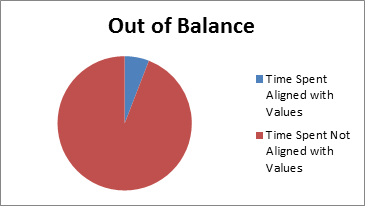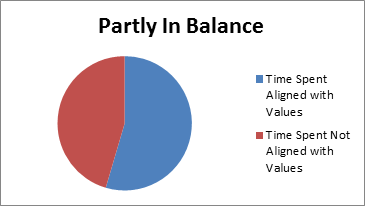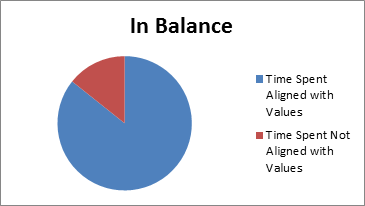You’ve probably heard the term “work-life balance” tossed around, often by well-meaning human resources staff.
And if you’re like me, you politely stared at them while secretly rolling your eyes so far back you could see your own brain.
But have you ever stopped to think what “balance” really means?
Are we in balance if we split our time 50/50 between “work” and “life”?
That’s baloney.
We can have more going on in our lives than ever and feel balanced. Or we can be focused on one or two things and feel out of balance.
How is that possible?
WHAT IS LIFE BALANCE ANYWAY?
To figure out balance, we first have to toss out the traditional view that it’s some sort of work/life split.
This view fails to take into account the most important factor for life satisfaction: our core values.
Here is my personal definition of balance:
“Our sense of balance comes from spending our time in a way that allows us to express most or all of our core values.”
Balance involves making the time for the things that matter most to us – and minimizing those that distract from our highest goals.
Values don’t just apply to “life” separate from “work”. We feel most balanced when we’re living from our core values as many hours of the day as possible – work included!
We need to be intentional about prioritizing what matters most to us on a daily basis – which becomes much easier when we’re crystal clear on what we truly value.
(Hint: If you haven’t yet received your free Values to Freedom worksheet, please do so now and complete the first two exercises. I’ll be here when you get back.)
Turn Your Values into a Life of Freedom
WHAT DOES BALANCE EVEN FEEL LIKE?
So we’ve answered the question of what balance is. But how do we know if we’re in balance? What does it feel like?
Our sense of balance looks something like this:

As we spend more time expressing our core values, we feel increasingly energized, fulfilled and on purpose.
This doesn’t happen overnight, and often involves creating some breathing room (including financial).
The warning sign that we need to make an immediate plan for change is when we regularly feel:
- Overwhelmed
- Dissatisfied
- Stressed
- Feel like we’re chasing a moving target
I’ve been there.
THE JOURNEY TOWARD BALANCE
During the second half of my Ph.D. studies, I felt overwhelmed, anxious, depressed, and disconnected from life.
I’ve written about the lessons learned from this experience – and why we should follow our hearts and not fear.
I felt that I was living very few, if any, of my core values.
That’s not a feeling I ever want to experience again.
Here’s how I spent my time:

After graduating, I chose a different path than one might expect a Ph.D. graduate to pursue, leaving research entirely.
This decision eventually brought me to leading a public-private partnership whose aim was to help startups succeed.
I loved doing work to help entrepreneurs realize their dreams. One of my favorite parts was collaborating with many wonderful people and organizations to achieve this goal.
The percentage of my time spent living from my values shot way up:

But 5 years into the job, I felt that I was called to do something different in life – to help people in another way, a way that helps remove barriers to self-actualization and greater fulfillment in life.
At the same time, I was expecting my second kid and wanted to be fully present.
When I took a hard look at my own values, I realized that my 9 to 5 wasn’t fitting in the picture.
Wait a second!
Give up the income and sense of purpose that a job can bring? A job I actually liked?
But our decisions become easy when they’re driven by our values.
It’s been two years since I left my 9 to 5, and I still feel energized, on purpose and more fulfilled than ever.
Like any of us, I have to spend some time doing things I’m not a fan of (such as having to make every meal at home from scratch due to a bunch of food sensitivities. Yikes!).
But for the most part, I get to do what I WANT to do instead of what I HAVE to do.
The chart now looks something like this:

Years of living below my means afforded this freedom to choose – and thus the privilege to live life on my terms.
Think about what YOUR “pie” looks like right now.
If it’s out of balance, don’t worry – once you recognize this, you’ll be able to quickly start moving in the direction you value, which we’ll cover next.
WHAT’S YOUR IDEAL DAY?
My values and choices may be completely different from yours because we are unique people.
The goal is to get you to think about YOUR values and start expressing them more fully.
After you’ve completed the first two exercises in the Values to Freedom worksheet, take 5 minutes and write down what your ideal day would look like.
Imagine that struggle is gone. Financial worries are gone. You have the freedom to live life on your terms.
What would that look like for you?
Here’s what it looks like for me at the moment.
It’s winter, and I love getting out into the snowy backyard at sunrise with a hot cup of tea, then getting some creative work done before the kids wake up.
I love dancing and playing with the kids when they get up. Then I dig into intellectual/business pursuits during preschool in the mornings, and hang out with the kids and go on adventures the rest of the time.
In the evenings, I enjoy creating with my husband Mark and/or performing storytelling and improv comedy on stage (my hobbies).
This ideal day may look different in the future as the kids get older – but it’s a typical day right now that captures a lot of my core values and gives me a sense of balance.
What does your ideal day look like?
Go ahead – write it down. I’ll see you back here in 5 minutes.
HOW TO MOVE TOWARD BALANCE
Fortunately, balance isn’t all or nothing. As the chart above shows, we can gradually make progress toward where we want to be.
And there are times we can temporarily slide back on certain values in order to meet a greater goal, and that’s okay.
Maybe we choose to slow down our pace toward certain goals while our kids are young, so we can be fully present with them.
Other times, maybe we need to ask for understanding and support from our family as we pursue our passion.
The key is to know when to say YES! to life – to pursue what excites, energizes, and sometimes even scares us – and to say NO to the rest.
We need to fiercely protect what matters to us, because saying an obligatory YES to something that drains our time and energy – and we later resent – is in fact saying NO to something that could move us closer to our highest goals and improved balance.
Time is our most precious, non-renewable resource – be mindful of how we use it!
The decision of what to say yes or no to becomes much, much easier when we’re clear on our core values (see Values to Freedom worksheet).
Turn Your Values into a Life of Freedom
STAYING TRUE TO OURSELVES
Saying NO doesn’t apply just to activities we’re not excited about, but also to purchases that drain our time and money.
There’s always going to be a pull to “keep up with the Jones’s” and to feel that what we own is a reflection of who we are.
Mark and I were recently expecting some friends over for dinner. We hadn’t seen them in years and I was excited to reconnect.
But I caught myself looking at our old leather couches, beaten to a pulp by active 5 and 2 year old kids, with stains from kid nail polish that someone had gifted to us (yes, it’s “washes off easily” from nails, but not couches!!!)
And part of me wondered if our friends would think less of us.
But I quickly shrugged it off.
I personally don’t think or care about people’s possessions – I love hanging out with people who have big ideas, dreams and passions, and who inspire me to think in new ways. People who are loving, kind and supportive.
Why would I think they would see me any differently?
Our minds will do this to us, and our core values are the go-to to keep us on track.
And when we’re living our values – which for many of us involves time with family and friends, creativity, helping others, healthy lifestyle, etc. – something amazing happens.
We realize we can live an abundant, rich life on significantly less money than we thought.
Result: The ability to design a life that gives us a sense of balance, purpose and joy.
ACTION STEPS
In summary, balance is not about a 50/50 allocation between “work” and “life. Balance comes from spending our time in alignment with as many of our core values as possible.
- Know YOUR core values (get the Values to Freedom worksheet below)
- Figure out where you are on the balance chart, and what your balance “pie” looks like right now
- Start creating a vision for a life that reflects your core values
- Say YES! to what truly matters
- Say NO to everything else – activities and purchases alike
- SAVOR the feeling of increased energy, fulfillment, and sense of purpose – and use it to motivate you to keep going
Let us know in the comments where you are today and where you’d like to be.
You’ve got this!



